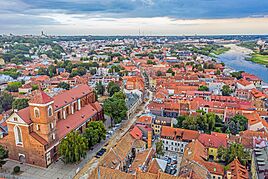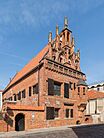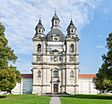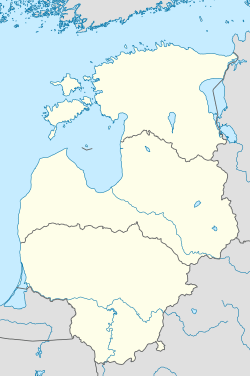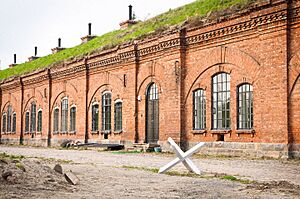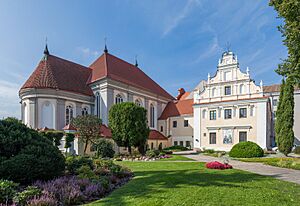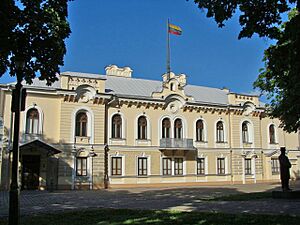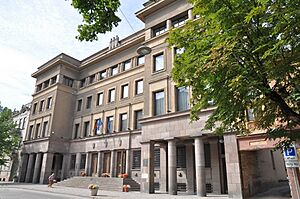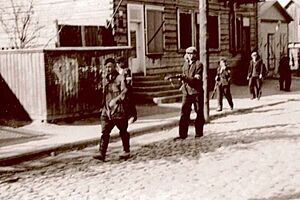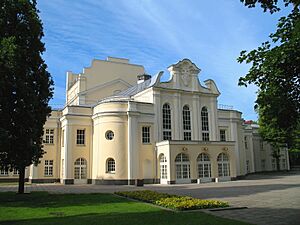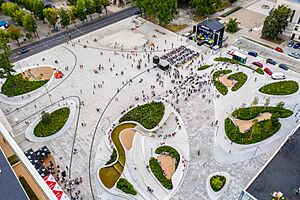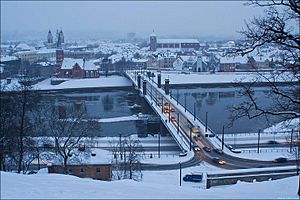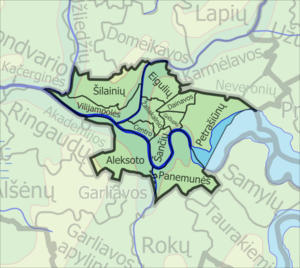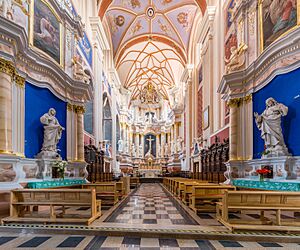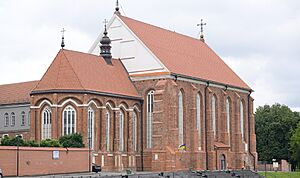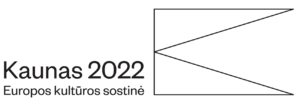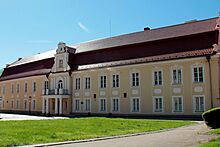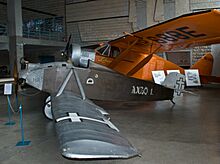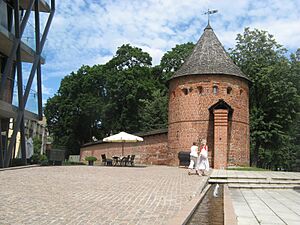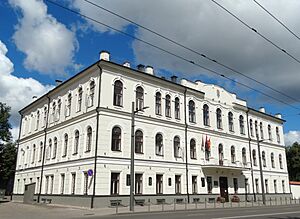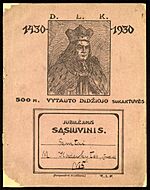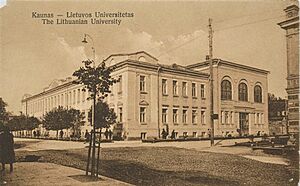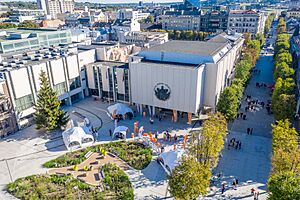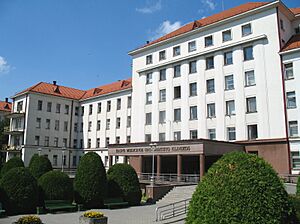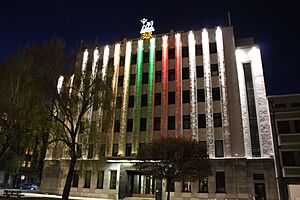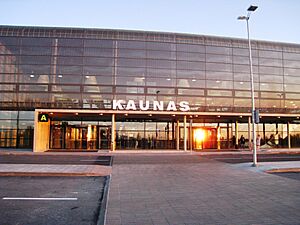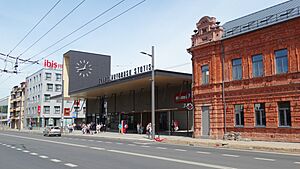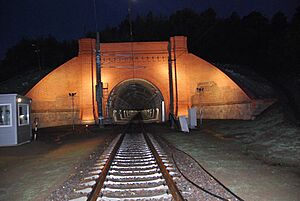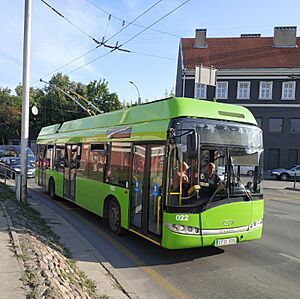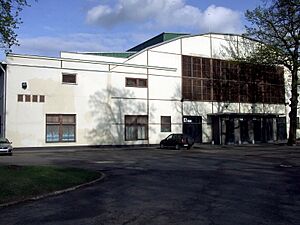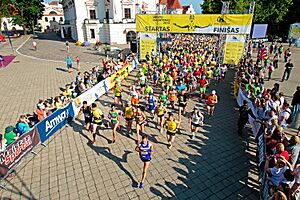Kaunas facts for kids
Quick facts for kids
Kaunas
|
|||
|---|---|---|---|
|
City
|
|||
|
Kaunas Old Town
Kaunas Castle
House of Perkūnas
Kaunas Town Hall
Church of St. Francis Xavier
Kaunas Reservoir
Pažaislis Monastery
|
|||
|
|||
| Nickname(s): | |||
| Motto(s):
Diligite justitiam qui judicatis terram
(Latin: Cherish justice, you who judge the earth) |
|||
| Country | |||
| County | Kaunas County | ||
| Municipality | Kaunas city municipality | ||
| Capital of | Kaunas County | ||
| First mentioned | 1361 | ||
| Granted city rights | 1408 | ||
| Elderships |
List
Aleksotas
Centras Dainava Eiguliai Gričiupis Panemunė Petrašiūnai Šančiai Šilainiai Vilijampolė Žaliakalnis |
||
| Government | |||
| • Type | Mayor-council government | ||
| Area | |||
| • City | 157 km2 (61 sq mi) | ||
| • Urban | 1,653 km2 (638 sq mi) | ||
| • Metro | 8,086 km2 (3,122 sq mi) | ||
| Elevation | 48 m (157 ft) | ||
| Population
(2024)
|
|||
| • City | 304,210 | ||
| • Density | 1,903/km2 (4,930/sq mi) | ||
| • Urban | 393,397 | ||
| • Urban density | 230/km2 (600/sq mi) | ||
| • Metro | 623,262 | ||
| • Metro density | 77/km2 (200/sq mi) | ||
| GDP | |||
| • Metro | €13.7 billion (2022) | ||
| Time zone | UTC+2 (EET) | ||
| • Summer (DST) | UTC+3 (EEST) | ||
| Postal code |
44xxx – 52xxx
|
||
| Area code(s) | (+370) 37 | ||
| City budget | €680 million | ||
| Climate | Dfb | ||
| Website | www.kaunas.lt | ||
| Official name: Modernist Kaunas: Architecture of Optimism, 1919-1939 | |||
| Type: | Cultural | ||
| Criteria: | iv | ||
| Designated: | 2023 (45th session) | ||
| UNESCO region: | Europe | ||
Kaunas is the second-largest city in Lithuania, right after Vilnius. It's also a very important place for Lithuania's economy, schools, and culture. Kaunas sits where two of Lithuania's biggest rivers, the Nemunas and the Neris, meet. It's also close to the Kaunas Reservoir, which is the largest lake in Lithuania.
For a long time, Kaunas was a major city in the Grand Duchy of Lithuania. From 1843 to 1915, it was the capital of the Kaunas Governorate under the Russian Empire.
Between World War I and World War II, Kaunas became the temporary capital of Lithuania. This happened because Vilnius was controlled by Poland at the time. During this period, Kaunas was famous for its lively culture, fashion, and many beautiful buildings in the Art Deco style. It was even called the "Little Paris" of that time! Its unique architecture has earned it the European Heritage Label and made it a UNESCO World Heritage Site in 2023.
In 2022, Kaunas was chosen as the European Capital of Culture, sharing the title with other cities. Today, Kaunas is the capital of Kaunas County and an important center for learning, with many students coming to its universities each year.
Contents
- What's in a Name?
- Kaunas's Coat of Arms
- A Look Back in Time
- Geography of Kaunas
- Administrative Divisions
- Religion in Kaunas
- Exploring Kaunas
- Learning in Kaunas
- Parks and Green Spaces
- Economy of Kaunas
- Demographics of Kaunas
- City Government
- Getting Around Kaunas
- Fun and Games in Kaunas
- Annual Events
- Kaunas and the World
- Images for kids
- See also
What's in a Name?
The name Kaunas comes from the Lithuanian language. It probably comes from a person's name. Before Lithuania became independent again, the city was often called Kovno in English. This was a more Slavic way of saying its name.
A Story from the Past
A legend from the 16th century says that Kaunas was founded by Romans a very long time ago. They were supposedly led by a noble named Palemon. He had three sons, and one of them, Kunas, built a fortress where Kaunas is now. The city was then named after him.
Kaunas's Coat of Arms
In 1408, Vytautas the Great gave Kaunas special city rights and chose its coat of arms. This coat of arms showed an aurochs, which is a type of wild ox.
Today, the coat of arms of Kaunas shows a white aurochs with a golden cross between its horns, all on a red background. This symbol was first used around 1400 and is the oldest city symbol known in the Grand Duchy of Lithuania. The current design was brought back in 1993.
A Look Back in Time
Early Days of Kaunas
Archaeologists have found old pottery and tools from as far back as 2000-1000 BC in the Kaunas area. This shows that people have lived here for a very long time.
The Grand Duchy Era
A settlement started in the area of Kaunas Old Town by the 10th century AD. Kaunas was first mentioned in writings in 1361. By the end of the 13th century, Kaunas Castle was built from bricks to protect the people from attacks by the Teutonic Order. This castle was very important because it stopped invaders from going deeper into Lithuania.
In 1362, the castle was captured and destroyed by the Teutonic Order after a long siege. Many defenders were killed. The Lithuanians tried to rebuild it several times, but the fighting continued until 1404, when Lithuanians finally took full control.
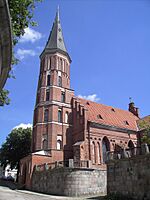

In 1408, Kaunas was given special city rights by Vytautas the Great. This meant the town could govern itself. Kaunas became an important trading center because it was located where rivers met and trade routes crossed. In 1441, Kaunas joined the Hanseatic League, a powerful group of trading cities. This helped Kaunas grow very fast.
By the 16th century, Kaunas had its own public school and a hospital. It was one of the strongest towns in the country. The city saw its biggest economic growth in the late 16th and early 17th centuries, leading to many new brick buildings.
However, Kaunas also faced tough times. In 1665, the Russian army attacked the city. In 1701, the Swedish army took over during the Great Northern War. The city also suffered from the bubonic plague and big fires in the 18th century.
Under Russian Rule
In 1795, Kaunas became part of the Russian Empire. During Napoleon's invasion of Russia in 1812, his army passed through Kaunas twice, causing a lot of damage. A hill in Kaunas is even named Napoleon's Hill.
To protect its western borders, Russia built the Kaunas Fortress around the city. You can still see parts of this fortress today. In 1862, a railway was built connecting Russia and Germany, making Kaunas an important railway center. It even had one of the first railway tunnels in the Russian Empire.
After an uprising in 1863, the Russian authorities moved the Catholic Seminary to Kaunas. This seminary became a key place for the Lithuanian National Revival, a movement to bring back Lithuanian language and culture. Many students from the seminary became book smugglers, secretly bringing Lithuanian books into the country when the Russian government tried to ban them.
Before World War II, Kaunas had a large Jewish population, making up about 35% of the city. They played a big role in the city's culture and business.
A Temporary Capital
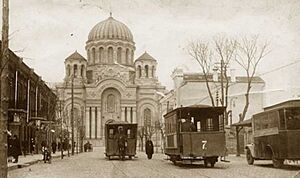
After World War I, Vilnius was taken by Poland. So, Kaunas became the temporary capital of Lithuania in 1919. It stayed the capital until 1939. During this time, Kaunas grew very quickly and became a modern city.
Under Mayor Jonas Vileišis (1921–1931), Kaunas was greatly improved. New water and sewage systems were built, the city expanded, and thousands of new buildings went up. Streets were paved, and horse-drawn trams were replaced by buses. New parks and neighborhoods were also created.
Kaunas was also an important military center. A war school was set up to train soldiers, and a factory was built to repair and make military aircraft. The city's air force became very strong.
The Jewish community in Kaunas was very active during this time, with many schools, synagogues, and businesses. The yeshiva in Slobodka was one of Europe's most respected Jewish learning centers.
In 1940, the Soviet Union took control of Lithuania. This led to many changes and difficulties for the people of Kaunas.
World War II and Beyond

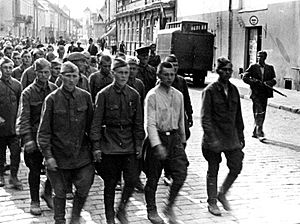
When the Soviet Union took over Lithuania in 1940, many people were arrested or sent away. In June 1941, when Nazi Germany attacked the Soviet Union, Lithuanians in Kaunas started an uprising to try and regain their independence. They took control of important buildings like the Presidential Palace and the radio station. On June 23, 1941, Lithuania's national anthem was played on the radio in Kaunas, announcing the restoration of independence.

However, the Nazis soon took full control. They did not recognize the new Lithuanian government. During this time, the Jewish community in Kaunas faced terrible persecution. Many Jews were killed in the Kaunas pogrom and at places like the Seventh Fort and Ninth Fort. The Ninth Fort is now a memorial to the many thousands of people who died there.

In 1944, the Red Army returned, and Kaunas once again came under Soviet rule. Kaunas became a center of resistance against the Soviets. People protested, and secret publications like the Chronicle of the Catholic Church in Lithuania spread information about human rights violations.
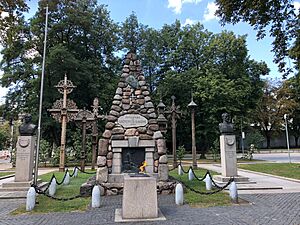
In the late 1980s, as the Soviet Union weakened, Kaunas became a key place for demonstrations and the Sąjūdis movement, which pushed for Lithuania's independence. In 1989, a huge crowd gathered in Kaunas to celebrate freedom and remember those who died for Lithuania.
Restored Independence
After Lithuania regained its independence in 1990, Kaunas continued to be an important industrial city. The city has improved its transport links with Western Europe, making it easier for tourists to visit.
Kaunas is also famous for its basketball team, BC Žalgiris. This team was a symbol of resistance against Soviet rule. In 2011, the Žalgiris Arena, the largest indoor arena in the Baltic states, was built in Kaunas.
In 2023, Kaunas's unique interwar modern architecture was officially added to the UNESCO World Heritage Sites list.
Geography of Kaunas
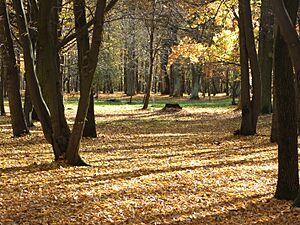
Kaunas covers about 15,700 hectares. A large part of the city, about 8,329 hectares, is made up of parks, gardens, and nature areas. Kaunas is known for its beautiful river valleys, as it sits where the Neris and Nemunas rivers meet.
The city has 16 urban parks, covering over 1000 hectares. There are also three forest parks and several nature reserves, including the Kaunas Reservoir Regional Park. This park protects the unique landscape and ecosystem around the Kaunas Reservoir.
Climate in Kaunas
Kaunas has a humid continental climate. This means it has warm summers and relatively cold, snowy winters. The average temperature for the year is about 7°C.
Even though it's in the north, Kaunas has a milder climate than some other places at the same latitude. This is mainly because of the nearby Baltic Sea. The Kazlų Rūda Forest, west of Kaunas, also helps to keep the air moist and protect the city from strong winds.
Administrative Divisions
Kaunas is divided into smaller areas called elderships. These are like neighborhoods or districts.
Religion in Kaunas
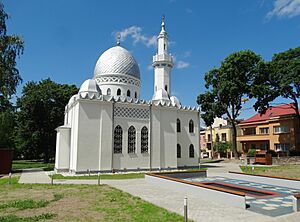
After Lithuania became Christian in 1387, churches and schools started to appear. Vytautas the Great helped build the Church of Vytautas the Great around 1400. The Kaunas Cathedral Basilica also started in the 15th century and is now the main Catholic church in Kaunas.
Many other churches were built over the centuries, including the Church of St. George the Martyr and the Pažaislis Monastery, which is a beautiful example of Baroque architecture.
In the 19th century, the main Catholic seminary was moved to Kaunas. It became a center for the Lithuanian National Revival, helping to preserve the Lithuanian language and culture.
During the interwar period, the Catholic Church was very important in Lithuania. In 1930, the Kaunas Mosque was built to honor Vytautas the Great and the Lipka Tatars, a Muslim group who had lived in Lithuania for a long time.
After World War II, religious buildings were taken over by the Soviets, and religious practices were restricted. However, people continued to practice their faith, often in secret. After Lithuania regained independence, churches and religious institutions were restored.
Exploring Kaunas
Kaunas is a city full of culture. The Old Town is where you'll find many old buildings and historical sites. East of the Old Town is the New Town, which started developing in 1847. The main street in central Kaunas is Laisvės alėja (Liberty Avenue), a long pedestrian street lined with trees and flowers.
The Old Town is best explored on foot. Important places to see include Kaunas Castle, the Town Hall, and the Historical Presidential Palace. The Town Hall was a center for trade and festivals in medieval times. It was rebuilt several times after fires and now houses the Museum of Ceramics.
Other interesting cultural spots in Kaunas:
- The Tomb of the Unknown Soldier and Eternal flame in Vienybės Square, honoring those who died for Lithuania's freedom.
- Kaunas Fortress, a large military fortress from the 19th and 20th centuries. It includes the Ninth Fort, a site of great historical importance.
- House of Perkūnas, a beautiful old building.
- Two funiculars (cable railways) – the Žaliakalnis Funicular Railway and the Aleksotas Funicular Railway.
- The Lithuanian open-air Ethnographic Museum in Rumšiškės, which shows what rural life in Lithuania was like long ago.
Museums to Explore
Kaunas has many museums! Here are some of them:
- The War Museum of Vytautas the Great
- The M. K. Čiurlionis National Art Museum, dedicated to the artist Mikalojus Konstantinas Čiurlionis who combined painting and music.
- The Žmuidzinavičius Museum (also known as the Devils' Museum), which has a collection of over two thousand devil sculptures from around the world.
- Lithuanian Aviation Museum
- Museum of the History of Lithuanian Medicine and Pharmacy
- Historical Presidential Palace, showing exhibits from the interwar period.
- Sugihara House-Museum, dedicated to a Japanese diplomat who saved many Jewish refugees during World War II.
Theatres and Shows
Kaunas has a lively arts scene. The Kaunas Symphony Orchestra performs classical music. The city also has a long circus tradition. There are many professional and amateur theaters, including:
- Kaunas State Drama Theatre
- Kaunas State Musical Theatre
- Kaunas Pantomime Theatre
- Kaunas State Puppet Theatre
Urbanism and Architecture
Kaunas has a mix of old and new buildings. The Old Town has many valuable buildings from the Gothic and Renaissance periods, like Kaunas Castle and the Town Hall.


The Pažaislis Monastery is a famous example of Baroque architecture in Lithuania. Other Baroque buildings include the Kaunas Lutheran Holly Trinity Church.
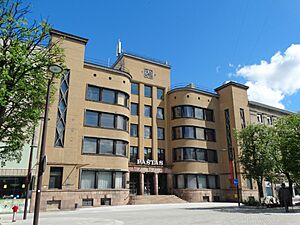

When Kaunas was the temporary capital (1919-1940), the city was greatly modernized. Over 10,000 new buildings were constructed, changing the city's look. Many buildings from this period show Neoclassicism and Modernism styles, like the Bank of Lithuania building and the Kaunas Central Post Office.
In 2023, Kaunas's modernist architecture from the interwar period was added to the UNESCO World Heritage Sites list.
After World War II, new buildings continued to be constructed, including the Kaunas railway station and the Kaunas Hydroelectric Power Plant. More recently, modern buildings like the Žalgiris Arena have been built.
Learning in Kaunas
Schools and Universities
The first school in Kaunas was set up near a church in 1473. In 1648, the Kaunas Jesuit College was founded, offering high school education.
In the 19th century, a gymnasium (a type of high school) was moved to Kaunas, which is now the Kaunas Maironis University Gymnasium. Even though there were times when the Russian government tried to limit the Lithuanian language, many people in Kaunas still learned to read and write.
During the interwar period, when Kaunas was the capital, Lithuania's education system was greatly improved. Many new schools were opened, and children were taught about patriotism. By 1939, 92% of the population in Lithuania could read and write.

Kaunas is a big center for higher education. In 1922, the University of Lithuania was founded in Kaunas. Today, its legacy is shared by three major universities:
- Vytautas Magnus University (VMU)
- Kaunas University of Technology (KTU)
- Lithuanian University of Health Sciences (LSMU)
There is also the Lithuanian Sports University, which trains specialists in physical education and sports. Kaunas is often called the "student city" because so many students come here to study.
Libraries
Kaunas has many libraries. The most important one is the Kaunas County Public Library. It has over 2.2 million books and other materials.
Parks and Green Spaces
Kaunas has many parks and open spaces. About 7.3% of the city's land is parkland. Ąžuolynas (Oak Grove) is a large public park in the heart of Kaunas, with many old oak trees.
The Vytautas Magnus University Botanical Garden was founded in 1923. It's a great place for people to relax and see local plants. Kaunas also has the only state-operated Kaunas Zoo in Lithuania.
Petrašiūnai Cemetery is a special burial place for important people in Lithuanian history. There are also old Jewish cemeteries in the city.
Economy of Kaunas

Kaunas is a big center for industry, trade, and services in Lithuania. Its main industries include food and drinks, textiles, chemicals, and wood processing. Recently, technology and electronics have also become important.
Many major Lithuanian and international companies have their main offices in Kaunas. Because of its location, Kaunas is also a big center for logistics and transportation.
The Kaunas Free Economic Zone has attracted many foreign investors. In 2017, Continental AG, a big car parts manufacturer, decided to build a new factory in Kaunas, which was a very large foreign investment.
Kaunas is also known for its programmers who have developed software for international companies.
Demographics of Kaunas
Today, most of the people living in Kaunas are Lithuanians, making up over 94% of the population. Other groups include Russians, Ukrainians, and Poles.
In 1923, the population of Kaunas was more diverse:
- Lithuanians – 58.9%
- Jews – 27.1%
- Poles – 4.5%
- Germans – 3.5%
- Russians – 3.2%
City Government
The Kaunas city municipality council is in charge of running the city and making its laws. It has 41 members, including the mayor, who are elected for four-year terms.
Getting Around Kaunas
Airports
Kaunas International Airport is the second busiest airport in Lithuania. Many low-cost airlines use it. The smaller S. Darius and S. Girėnas Airport, established in 1915, is one of Europe's oldest airports still used for tourism and air sports. It also hosts the Lithuanian Aviation Museum.
Bus Stations
The Kaunas bus station was completely renovated and reopened in 2017. It's the largest and most modern bus station in Lithuania, with many shops and cafes. It serves both local and international bus routes.
Highways
Kaunas is connected by several major highways. The European route E67, also known as the Via Baltica, connects Kaunas to other Baltic states and beyond. Kaunas is also linked to Vilnius and Klaipėda by the A1 motorway.
Bridges
Because Kaunas is located where two rivers meet, it has many bridges. Some important ones include:
- Vytautas the Great Bridge, connecting the Old Town with Aleksotas.
- M. K. Čiurlionis Bridge, a car bridge across the Nemunas.
- The Green railway bridge, built in 1862.
Railways
Kaunas is an important railway hub. The first railway connection was built in 1859–1861, including the Kaunas Railway Tunnel and a railway bridge. Kaunas Railway Station has direct passenger connections to Vilnius and Warsaw.
Public Transportation
Kaunas has a public transportation system with 14 trolleybus routes and 43 bus routes. You can buy electronic tickets using a special card or a mobile app called Žiogas (Grasshopper).
Kaunas also has two funiculars, the Žaliakalnis Funicular and the Aleksotas Funicular, both built in the 1930s.
Fun and Games in Kaunas
Sports City
Kaunas has a rich sports history. It's home to famous clubs like the Žalgiris basketball club, which is one of Europe's strongest teams. They play their home games at Žalgiris Arena, the largest indoor arena in the Baltics.
The city also has the Darius and Girėnas Stadium, which is used for soccer and athletics. It was recently renovated and is now a top-class stadium.
Kaunas hosts the Kaunas Marathon every year, with thousands of participants. Many famous Lithuanian basketball stars, like Arvydas Sabonis and Šarūnas Marčiulionis, were born or grew up in Kaunas.
The Nemuno žiedas is Lithuania's only motor racing circuit, located near Kaunas. There's also a yacht club at the Kaunas Reservoir Regional Park.
In 2023, Kaunas hosted the 2023 EuroLeague Final Four, a major basketball event, for the first time in Lithuania's history.
Annual Events
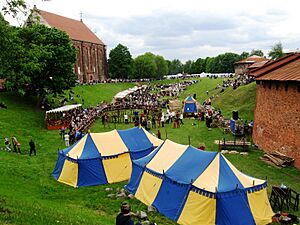
Kaunas is known for its many festivals, including:
- Kaunas Jazz Festival (April–May)
- International Operetta Festival
- Photo Art Festival "Kaunas photo"
- Pažaislis Music Festival (June–August)
- Day of Kaunas city (middle of May)
- Christmas tree lighting (end of November)
Kaunas and the World
Twin Towns and Sister Cities
Kaunas is twinned with many cities around the world, which means they have special friendly relationships and often work together on projects. Some of these cities include:
- Białystok, Poland
- Brno, Czech Republic
- Grenoble, France
- Kharkiv, Ukraine
- Los Angeles, United States
- Odense, Denmark
- Riga, Latvia
- Tampere, Finland
- Tartu, Estonia
- Toruń, Poland
- Wrocław, Poland
- Xiamen, China
- Yaotsu, Japan
Images for kids
-
President Antanas Smetona inspects the Lithuanian Army soldiers
-
Chiune Sugihara House in Kaunas
-
Soviet political leader (without military straps) and the People's Seimas member (with red rose in his jacket lapel) announces to the Lithuanian People's Army non-commissioned officers that "soon you will become members of the Red Army" in Kaunas, 1940
-
Cafés in the Kaunas Old Town
-
Kaunas Central Post Office is one of the most recognizable buildings of interwar Lithuania
-
Romuva Cinema, the oldest still operational movie theater in Lithuania, which was initially opened in 1940
-
Aerial view of the Kaunas University of Technology Campus
-
Coin of the Grand Duchy of Lithuania, minted in Kaunas Mint, 1665
-
Hanseatic Days in Kaunas
See also
 In Spanish: Kaunas para niños
In Spanish: Kaunas para niños


